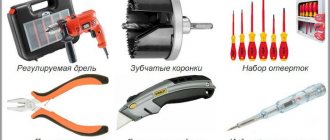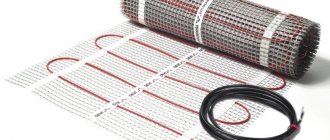When assembling a pipeline and installing various plumbing equipment, it is necessary to firmly seal the joints of pipe parts in order to avoid water or gas leaks. There are various materials for this. One of the most popular tools for sealing is FUM tape. Its use has its own subtleties and nuances, so you need to know how to wind FUM tape correctly so that no problems arise during the installation process.
FUM tape Source wellmart.net
Where is it used?
Due to its properties and characteristics, FUM tape is used in most situations where sealing treatment is required.
- Water pipes . The most important thing that FUM tape is used for is sealing water connections. The material is water-repellent, which makes it almost indispensable for fastening water pipes and parts during the assembly and installation of equipment.
- Gas pipeline . The film can be made gas-tight, and it can be used to install gas appliances and meters. However, not every FUM tape is suitable for this purpose; you need to purchase a specialized tape for gas.
- Technique . The material is characterized by resistance to various types of influences, therefore it is actively used to repair internal mechanisms of cars and various technical devices.
Heating pipes fastened with tape Source re-st.ru
Pros and cons of using
The main advantage of choosing tape is its availability. FUM is sold at a low price, cheaper than flax tow and most other sealants used in plumbing.
The material is characterized by ease of installation. With proper skill, winding the tape occurs in a matter of seconds, but for this you should practice winding it on connections of different diameters for some time.
An important advantage of using tape is that the parts fastened with it can be easily disassembled. The connections do not freeze tightly; they can be disassembled even years after installation.
The main disadvantage of the material is that it is not the most reliable of seals, therefore, as a rule, it is not used for industrial installation. However, for household repairs the hermetic properties of FUM are quite sufficient.
Another disadvantage is that the tape often protrudes outward from the joints, so the pipes may look sloppy because of this.
Tape on thread Source sdelairukami.ru
Solvent-based sealants
Such products undergo polymerization and completely harden some time after application. Curing occurs after the evaporation of the solvent present in the composition.
You can use sealants together with linen tape or on their own. Their advantages:
- serious level of fixation;
- strength and wear resistance of the seam;
- ease of installation of threaded connections;
- quick drying;
- low price.
Low quality materials may last slightly less, which is why the threads will have to be tightened periodically. If a thread gap that is too large is sealed with such a sealant, the seam will shrink over time.
Specifications
Let's consider the technical characteristics of the FUM tape, which determine its properties:
- the material is characterized by resistance to damage;
- has plasticity;
- retains its properties for a long time and does not need regular replacement;
- is environmentally friendly and does not emit harmful substances;
- heat-resistant, able to withstand a wide range of temperatures;
- the thickness is only two tenths of a millimeter;
- has dielectric properties and gas impermeability;
- elastic, capable of stretching almost twice its original length.
Using FUM for water connections
The use of sealed film for water connections has certain advantages compared, for example, with the use of flax tow and sealant
Taped water connections Source userapi.com
See also: Catalog of companies that specialize in water supply and sewerage work.
When using sealant, depending on its type, the connection can be sealed almost tightly, and if dismantling is necessary, the pipes will take a long time to disassemble.
The advantage of using FUM tape for water is that it does not interfere with the dismantling of pipes, is sufficiently waterproof and is easier to use. It can also be used together with flax as an additional sealant.
Non-hardening pastes
Another suitable sealant for gas or other pipes is a special non-hardening paste in the form of a viscous substance based on synthetic resins, acrylic and silicone, oils and various fillers. Such products are very easy to use: they need to be applied to the threads and the pipes are connected.
Positive qualities of pastes:
- the presence of additives against metal rusting;
- quick and easy thread tightening;
- easy dismantling of the system;
- no thread jamming during assembly.
Unfortunately, such pastes are only suitable for pipes under low pressure. If the pressure is high, the composition will soon be squeezed out of the thread. You should also not rely on strong fixation of pipes, as well as on the resistance of the products to sudden changes in temperature or the effects of aggressive chemicals.
It is best to use non-hardening pastes with flax or artificial threads to increase the reliability of the joint.
Using FUM for a gas pipeline
To fasten gas pipeline parts and install gas equipment, you should use only special FUM tape for gas. It must be supplied with a certificate of conformity confirming its suitability for use on gas pipes.
The special film for gas is yellow. It is made wider - up to two centimeters in width.
Yellow FUM tape for gas Source megastroy.com
The use of the material is possible only when sealing can only be achieved using a sealant. In the case of rubber hoses, as well as metal hoses, the sealing function is provided by a special gasket. In this case, the additional seal will not add tightness to the connection, and may even break it, as it will interfere with the tight fit of the gasket.
Rubber O-rings
This type of seal is used for connections where the distance between the ends does not exceed 1 mm. RUK is not used for sealing couplings in which the end of the threaded pipe does not abut the end of the nut or other pipe. They are used to seal water tap connections.
Rubber O-ring
If the old RUK is damaged and the tightness of the connection is broken, turn off the water, disassemble the connection and remove the seal. If it is not possible to purchase a ready-made RUK, take rubber (for example, from a wheel tube of a car or truck), attach the damaged seal to it and trace the contours with a pen. If the rubber is thinner than the old RUK, make two or three rings. Cut out a new seal and insert it into the nut. If necessary, trim off any protruding parts. A correctly marked and cut seal is inserted into the nut with force. Reassemble the connection and check for leaks.
How to wind tape
In fact, to figure out how to properly wind FUM tape onto a thread, you do not need to have any special skills. However, certain operating features should be taken into account in order to protect connections from leaks.
Before winding FUM tape, you must first thoroughly clean the parts. All joints must be treated with a solvent and dried to prevent debris from getting under the tape.
Winding tape onto a thread Source sovet-ingenera.com
The need for compaction
Sealing sewer pipes, like sealing all water pipes, is a very essential step in the pipeline installation process. It is especially important to properly seal the joints.
To prevent the pipeline from leaking, since the appearance of unpleasant odors in an apartment or private house depends on this, it is necessary to choose the right seal for sewer pipes.
This means that you need to know which sealant is best for sealing plastic, polypropylene, cast iron, steel and other products. You also need to have information about how to seal threaded connections of a water supply system, couplings, and flanges.
You need to familiarize yourself with other materials necessary for the repair or installation of heating systems, gas supply, repair of sewers designed for draining acids and alkalis, and other systems, so that, if necessary, you can do such work yourself.
Now let’s talk about how to seal any pipe in order and in more detail.
Things to consider
When working with tape, it is necessary to take into account some of its characteristic features.
- The tape is quite slippery, so you need to wind it carefully so that the strips do not move out of bounds. It is advisable not to allow the edge to fall out into the inside of the connection.
How the tape should be positioned on the thread Source abro-ind.ru
- Once the film has already been wound, it cannot be unwound and re-wound - this will break the tightness. Try to process it carefully right away, otherwise you will end up wasting a lot of material.
- Also, the tightness will be broken if there is a need to loosen the connection. In this case, you will also have to rewind the material.
The role of sealing
If external defects in pipes can be easily corrected, then in order to seal the pipe connections during operation, it will be necessary to completely suspend the functioning of the sewer system.
That is, re-sealing cast iron sewer pipes or hot water risers is the same as starting to re-install the pipeline system. Therefore, leaks into the water supply system should be avoided (for example, to prevent groundwater from entering the pipeline).
It is equally important that there are no slightest leaks from inside the sewer system, since this is fraught with the appearance of not only unpleasant odors, but also a possible destructive effect on the walls of wet discharge from the pipe.
Other seal options
Of course, FUM tape is not the only existing option for sealing joints. Among others, linen tow should be highlighted, along with which various types of sealants, as well as plumbing thread, are used to fasten pipe parts. Let's consider their advantages and disadvantages in comparison with FUM.
Flax tow
Linen is also one of the most popular materials. Just like FUM, it is customary to wrap tow in a dense layer.
It is important to wind the tow carefully and tightly, filling the thread completely along the turns. The outside of the fibers is additionally coated with paint or sealant. This leads to the main disadvantage of this material. It should be borne in mind that if paint is used, the connections cannot be dismantled and the pipes will be unsuitable for repair.
Flax tow Source ytimg.com
Also, the disadvantage of this material is its relative fragility. Unlike tape, flax is subject to gradual decomposition under the influence of moisture.
The main advantages of tow in comparison with FUM are:
- Adjustability. After winding and securing the connection, it is possible to unscrew it at a slight angle without loss of tightness and the need to replace the sealing material.
- Reliable sealing, high degree of tightness and ability to absorb liquid.
- High resistance to various types of physical influences.
- Easy to disassemble the connection.
If you have to choose what is better to use – ribbon or linen tow, then there is no definite answer. As a rule, it is recommended to use tow for intermediate pipeline connections. The tape is more suitable for securing taps, meters and mixers.
Sealants
When using flax tow, for a better fit and seal, the joint is additionally treated with a liquid sealant.
Liquid sealants Source ad-cd.net
Characteristic properties
All sealants have a special set of qualities that you need to know and be able to evaluate:
Fluidity. This refers to the viscosity of the sealant. So, if you need to close a small gap, it is better to choose a gel or paste. Their texture is perfect for this. If we are talking about sealing a large gap, then it is necessary to purchase the most liquid composition. Remember that the larger the gap, the thinner the sealant should be. This way he can fill all the cracks, tightly fastening the pipe connection.
Temperature. The operating temperature range of sealants is not infinite. At a certain temperature, they will no longer firmly fix the pipe, which can lead to leakage. For most samples on the market, the temperature range is 200 degrees - from -50 to +150. Usually this is more than enough
If it is necessary to seal pipes through which a colder substance flows (for example, pipes for liquefied gas), then you need to pay attention to specialized samples.
Strength. Strength refers to how much force must be applied to separate a joint. If a sealant of low strength was used, then it will be enough to apply strong force with your hands. The fitting, sealed with medium strength sealant, can only be unscrewed when using additional equipment. It is impossible to dismantle the strong fixation sealant: the joint will have to be broken.
Polymerization rate. The packages indicate how long it takes for the sealant to completely cure. You can start using the pipes only after this time has expired.
The maximum thread diameter that can be fixed. It just so happens that not all sealants work on all pipes. If the composition is incorrectly selected, the beneficial effect of its use is reduced to zero.
Possibility of use. Some sealants are not suitable for fixing pipes carrying drinking water because they release toxic compounds into the water
You need to pay close attention to this factor.
Briefly about the main thing
FUM tape is one of the popular and effective sealing options. It is affordable, easy to use, and does not create problems during subsequent repairs.
There are several simple rules on how to wind FUM tape onto a thread:
- the winding area must be cleaned;
- the tape is wound along the thread - how the nut will move along it;
- When winding the tape, you need to tighten it a little;
- Usually four layers are enough, but sometimes more are required;
- After winding the tape, the thread relief should be palpable.
Anaerobic adhesive sealants
Anaerobically curing gel sealants are ideal for sealing metal threaded connections. They penetrate even the smallest cracks and gaps and undergo polymerization when contact with oxygen ceases. Under normal conditions, sealants remain liquid for a long time, but as they harden, they turn into a durable mass like plastic.
Using anaerobic sealant is very simple. It can be applied to the thread with a brush or squeezed out of a tube, then smeared and tightened. After 15–60 minutes, the joint will be completely sealed, but another day must pass before the gas equipment can be used. The most popular brands of anaerobic compounds are:
- "SantechMaster";
- Loctite 577;
- Loxeal 58;
- Unitec EASY.











